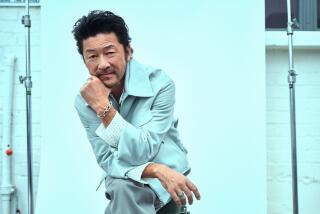Don’t get between the rabbit and his sword
- Share via
TWENTY-one years ago, a rabbit in samurai costume seeking shelter from a blizzard announced, “I am called Miyamoto Usagi” -- and so began one of the most remarkable sustained narratives in the history of the comics. An eclectic blend of American and Japanese elements, Stan Sakai’s “Usagi Yojimbo” (“Rabbit Bodyguard”) continues to delight audiences more than two decades after the series debuted, winning the National Cartoonists’ Society Award and the comic book industry’s Will Eisner Award.
The title comes from Akira Kurosawa’s classic 1961 film “Yojimbo.” A ronin (a masterless, roving samurai), Usagi began as a bodyguard for hire, but he quickly became a wanderer, following the musha shugyo (warrior’s path) to perfect his spiritual and martial skills. Although his name comes from the Japanese warrior-hero Musashi Miyamoto, Usagi sometimes recalls Alan Ladd in “Shane.” He’s the stranger who walks into town to right a wrong, throw out a tinhorn bully or solve a baffling mystery.
“Usagi Yojimbo” is set in Japan at the dawn of the 17th century, after the first Tokugawa shoguns established their military dictatorship, ending an era of civil wars. A samurai from a rural village, Usagi served as a retainer to Lord Mifune (named for Japanese actor Toshiro Mifune). He became a ronin -- and acquired the trademark scar over his left eye -- when his suzerain was slain in battle through the treachery of Lord Hikiji, the only human in Sakai’s cast of anthropomorphized animals.
Usagi has a more complex personality than most comic book characters. An honorable and highly disciplined practitioner of Bushido, the warrior’s chivalric code, he despises all bullies. He’ll help anyone in trouble, and his inability to mind his own business often lands him in trouble. His mischievous sense of humor balances his volatile temper. Usagi prefers to dispatch foes by clobbering them with his scabbard, but when he’s forced to unsheath his weapon, his consummate skill as a swordsman (swordsrabbit?) enables him to finish off his enemies swiftly and decisively.
Most of Usagi’s recent adventures have involved his son, Jotaro. Just before he entered Lord Mifune’s service, Usagi went on a picnic with his childhood sweetheart, Mariko. Usagi’s childhood rival, Kenichi, married Mariko a few months later, knowing she was pregnant, and raised Jotaro as his own son. In the latest collections, “Travels With Jotaro” (Book 18) and “Fathers and Sons” (Book 19), Usagi agonizes over whether he should tell Jotaro who his true father is and risk damaging the boy’s relationship with Kenichi. It’s a much more interesting relationship than the one comic book heroes generally share with their wards and nephews.
Sakai rounds out his cast with an assortment of entertaining supporting characters: Katsuichi-sensei, the hermit who instructs both Usagi and Jotaro in the martial arts; Gen, the incorrigible bounty hunter; Kitsune, a street performer and pickpocket; Tomoe, the beautiful lieutenant of a feudal lord; and Chizu, the chief of the Nekko Ninja clan. They’re pitted against appropriately flamboyant villains, who range from two-bit gangsters and professional assassins to power-hungry nobles and the insidious Lord Hebi.
An eerie darkness pervades Usagi’s battles with Jei, a deathless fanatic who believes he’s the messenger of the gods. But Sakai plays that darkness against broad comedy: Godzilla and the Teen-Age Mutant Ninja Turtles have made cameo appearances in “Usagi Yojimbo.” (Turtles co-creator Peter Laird is a friend of Sakai’s.) Even Jei’s name is a pun: When the standard Japanese honorific “-san” is attached, it becomes “Jei-san” or Jason, the villain of the “Friday the 13th” movies.
But contemporary anachronisms appear only rarely in “Usagi Yojimbo.” Sakai’s carefully researched artwork accurately depicts the details of Edo-era costumes and architecture. Similarly, the stories incorporate elements of traditional Japanese myths and Kabuki plays. Usagi has encountered tengu (forest goblins) and kappa (water demons); he has even appeared as the hero in a retelling of the classic Japanese folk tale about Momotaro (“The Peach Boy”) in “Grey Shadows” (Book 13).
In Sakai’s most ambitious story, collected in “Grasscutter” (Book 12) and “Grasscutter II: Journey to Atsuta Shrine” (Book 15), Usagi finds Kusanagi, the sword of the sun goddess Amaterasu, which was lost in a sea battle in 1185. He knows this sacred relic would tempt any ambitious nobleman to overthrow the shogun and make himself ruler of Japan. Where can it be safely kept? It’s not the kind of dilemma an ordinary comic book hero could resolve -- or that any ordinary comic book artist would create.
Sakai’s crisp, calligraphic drawings convey both drama and comedy effectively. He uses the comic book panels like a skilled cinematographer, presenting the images in ways that advance the narrative: A series of small drawings may suggest the rapid movements leading to a large picture of the climactic sword fight between Usagi and his foe. The duels to the death are violent, but never unnecessarily gory.
During the last 21 years, Usagi has survived not only countless sword fights, pitched battles, attacks by monsters -- and the equally violent ups and downs of the American comic book industry. Yet readership for the series has never flagged. Gen-X fans who enjoyed “Usagi Yojimbo” as teenagers have begun passing dog-eared books on to their kids, creating a second generation of readers.
Not bad for a rabbit who came in from the cold. *
More to Read
The biggest entertainment stories
Get our big stories about Hollywood, film, television, music, arts, culture and more right in your inbox as soon as they publish.
You may occasionally receive promotional content from the Los Angeles Times.










